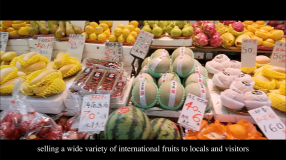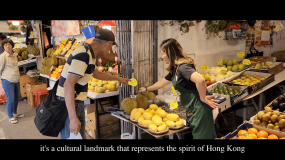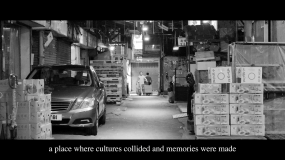Video Essay:
Disappearing City: Wholesale Fruit Market, Yau Ma Tei
Introduction
The video’s theme revolves around the concept of a disappearing fruit market, specifically focusing on the Yau Ma Tei wholesale fruit market. The subject of the video is the impact of redevelopment plans on this iconic market and the sentiments of the people who have been a part of it.
The setting of the video is in the heart of Hong Kong, where the Yau Ma Tei wholesale fruit market is located. The market is depicted as a vibrant and bustling place, filled with colorful displays of fruits and lively interactions between buyers and sellers. This setting serves as the backdrop for the narrative of the video that brings out the unique atmosphere and cultural significance of the market. The components of the video include various elements that contribute to its storytelling. It begins with a narrator’s voiceover, setting the stage by introducing the Yau Ma Tei fruit market as a cherished part of public memory and an iconic symbol of Hong Kong. The video incorporates shots of tourists exploring the market, capturing their experiences and interactions with the vibrant surroundings. Interview clips of shopkeepers who have been a part of the market for years are included to showcase their emotional connection to the place. Their expressions of sadness and nostalgia add a personal touch, highlighting the community aspect of the market and the impact the redevelopment plans will have on their lives.
The closing shot of the video presents a bittersweet view of the market, symbolizing the impending loss and the need to cherish the remaining days. To present this value, I have recorded some night view of the fruit market and the closing shot of it. This component leaves viewers with a poignant reminder of the fleeting nature of cultural landmarks and the importance of preserving collective memories.
Literature Review
To have a deep understanding of Yau Ma Tei wholesale fruit market, some researches are conducted. The history of Yau Ma Tei Market can be traced back to 1913, when the Hong Kong colonial government decided to build a new fruit and vegetable market on the reclaimed land next to Reclamation Street, and in the same year established the Yau Ma Tei Market, which was designated as a wholesale market for fruits, vegetables, rice, fish and poultry, with about 14 fruit stalls (Joey, 2022). Gloria (2009) pointed out that the fruit market is important due to its long history of 96 years, representing the history of Hong Kong and reflecting the ‘blood and sweat’ story of low-income people in old Hong Kong. Additionally, the market plays a crucial role in the social, cultural, and economic interactions of Hong Kong, forming a unique ‘spirit of place’ through tangible and intangible elements such as special building structures, distinctive spatial arrangements, and intangible wholesale activities.
Under this history background, Yau Ma Tei fruit market is not only a fruit market anymore, but also a community (Mayne, 2013). It is also a public memory of Hong Kong (Szeto, 2022), a cultural heritage of Hong Kong (Matthew, 2011). Yau Ma Tei fruit market is a vibrant and harmonious community where diverse groups of people come together to appreciate the beauty of fresh produce (Martin & Chan, 2014). So, the main theme of the video is recording the current situation of Yau Ma Tei fruit market and raising the public awareness of the redevelopment.
Filming Methods
The style of the video will be documentary like, as I want to bring out as much information as possible to viewer. So I did not make many fancy visual effects and transitions, instead focusing to the whole view and photography. To start the video, I use the wide-angle establishing shot to bring out the object that can see the whole fruit market and the people walking around it.

Then, I include some shots to ‘bring’ the viewers walk through the community with me, like the close-up shot of the colorful exotic fruits and medium shot of the interact between the customers and sellers.


I used the high angle extreme long shot to show the whole view of fruit market to help viewers have a thorough imaging. To change the flow from introduction part to “redevelopment” part, I use some low angle shot to have a nonobvious transit.


At the last part that talks about the vanishing of fruit market, I wait for the night view and record the night scene like restocking and closing gate. It is also a comparison between the day view and night view of the fruit market, to present the lively community. About the background music, I chose the “Wedding Invitation Street”, which symbolizes the sorrow and remorse surrounding the demolition of Lee Tung Street in Wan Chai. I believe this song captures the essence of the current state of the Yau Ma Tei wholesale fruit market. And most important, can echo the audiences.


Conclusion
All in all, Yau Ma Tei Fruit Wholesale Market is not only a market, but also an important community and cultural heritage in Hong Kong. Despite the looming threat of redevelopment, it remains a thriving center where generations come together to foster a sense of belonging and preserve the city’s rich heritage. As we address the challenges of urban development, it is crucial to recognize the importance of this market and cherish it as an irreplaceable part of Hong Kong’s identity. Let us uphold the spirit of unity and cherish our cultural heritage.
Bibliography
Affleck, Janice. (2007). Memory capsules discursive interpretation of cultural heritage through digital media [Thesis (Ph. D.)–University of Hong Kong, 2007.]. https://doi.org/10.5353/th_b3858737
Debbie, C. S. K. (2018). A study of metamemory and memory of Hong Kong elders : measurement, correlates, and intervention outcome of a randomized controlled trial https://doi.org/10.5353/th_991044040580803414
Chan, H. L. A. (2010). Tracing a Sense of Place from Urban Heritage Landscape: Case Study in Yau Ma Tei (Doctoral dissertation, Chinese University of Hong Kong).
Fanny, A. B. H. (2008). Mapping memories a methodology to quantify the “collective memory” of places through the process of way-finding in Central [Thesis (M.Sc.)–University of Hong Kong, 2008.]. https://doi.org/10.5353/th_b4218901
Gloria, L. L. T. (2009). Transforming landscape Yau Ma Tei Wholesale Fruit Market [University of Hong Kong Libraries]. https://doi.org/10.5353/th_b4500983
Joey, P. S. J. (2022). The culture of fruit : a documentation of the tangible and intangible cultural heritage of the Ya Ma Tei wholesale fruit market. [University of Hong Kong Libraries].
Leung, P. S. J. (2022). The culture of fruit: a documentation of the tangible and intangible cultural heritage of the Ya Ma Tei wholesale fruit market. HKU Theses Online (HKUTO).
Litvak, Meir. (2009). Palestinian collective memory and national identity (1st ed.). Palgrave Macmillan.
Martin, J. T., & Chan, W. W. (2014). Hong-Kong-style community policing: a study of the Yau Ma Tei fruit market. Crime, Law and Social Change, 61, 401-416.
Mathew, F. W. H. (2011). Collective memories, identity and cultural heritage conservation a case study of Hong Kong [Thesis (M. Sc.)–University of Hong Kong, 2011.]. https://doi.org/10.5353/th_b4673671
Szeto, J. T. W. (2022). Spirit of Gwo Laan: Culture, Resiliency, and Identity of Hong Kong Public Wholesale Market.
Wayne, C. W. L. (2013). Community policing in the Yau Ma Tei wholesale fruit market in Hong Kong a social capital perspective [Thesis (Ph. D.)–University of Hong Kong, 2013.]. https://doi.org/10.5353/th_b5106497
Director: Cheng Chung Hin
Editor: Cheng Chung Hin
Camman:Cheng Chung Hin
Voice-over: Cheng Chung Hin
Cheng Chung Hin 3036230493
This video essay comprehensively and thoroughly explores the Yau Ma Tei Fruit Market, detailing its location, size, internal structure, and developmental history. The author examines the cultural significance of the market as a hub for generations of local community activity, supported by solid narrative and visual documentation. The author expresses a sense of loss over the market’s impending demolition and redevelopment, calling for greater attention to cultural heritage and a reevaluation of the conflicts between modern development and historical legacies.
I appreciate your film and I can feel the passion you have for this place. The essay gives an clear introduction to the Yau Ma Tei Wholesale Fruit Market and how it has been affected by the redevelopment programme. The article sets the stage for the film by describing the vibrant environment of the Fruit Market and its cultural significance. The inclusion of various narrative elements such as background sounds from the field, shots of tourists and the busy people in the film adds emotional depth and highlights the community aspect of the market. The closing shot creates a sense of sadness and emphasises the impending loss of the cultural landmark turn, fitting the theme.